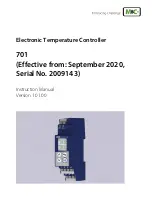
Appendix B: Single Point Linkage and Device Address Binding
RTU Open v3
CARRIER CORPORATION ©2019
Installation and Start-up Guide
All rights reserved
91
Single Point Linkage
The RTU Open receives data from other Open controllers when they are installed as part of an i-Vu® Control
System. The data transfer may take the form of Single Point Linkage (SPL), which is automatic, or Device Address
Binding, which you must configure.
Currently, the RTU Open implements Single Point Linkage for 2 variables:
•
System Cool Demand Level
•
System Heat Demand Level
Network Points for which SPL has been implemented are displayed in Field Assistant and the i-Vu® interface on
the
Properties
page >
Network Points
tab.
The following example involves outside air temperature.
System Heat & Cool Demand Level
behaves similarly,
except that their usage involves a specific application loaded on a Universal Controller Open. See
UC Open
Installation Guide
for additional information. In either case, note that the BACnet type and instance numbers
specified in the
Address
field of these variables have been predefined.
Network variables for which SPL is used are easily identified on the
Properties
page >
Network Points
tab. The
asterisk in the BACnet address invokes the SPL function. These addresses cause the controller to issue a BACnet
“who has” command for this variable. The controller binds to the closest of the first 5 devices from which it
receives a valid response.
Appendix B: Single Point Linkage and Device Address Binding
Summary of Contents for RTU Open v3
Page 113: ......
















































